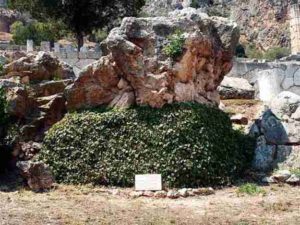2022.04.25 | By Gregory Nagy
[For the Greek text and for my working translation, see Part I.]
§0. Here in Part II of my two-part essay on Sibyls as we see them described by Pausanias, I analyze some salient divergences in the details reported by our traveler about various different Sibyls. By contrast, I had focused in Part I on one particular convergence in detail, which had to do with the primary role of all Sibyls, that is, the ‘singing’ of oracular words. This role, as we saw in Part I, tends to neutralize any differentiation between, say, the Sybil of Delphi and the Sybil of Cymae. The second of these two figures, as we also saw, has been made famous in world literature by way of Virgil’s narrative in Aeneid 6 about her oracular sayings spoken to Aeneas. But now I focus here in Part II on the divergences that differentiate the identities of the various Sibyls known to Pausanias.


§1. Even Pausanias, who tends to view Sibyls from a unified perspective, acknowledges the need to differentiate them from one another—at least, chronologically. For example, Pausanias says at 10.12.8 about Dēmō, Sibyl of Cumae, that she is a figure who supposedly lived in a later era than Hērophilē, who would be an earlier Sibyl according to what he says already at 10.12.1. Although even Hērophilē is not the earliest of all Sibyls in the thinking of Pausanias, our traveler nevertheless seems certain that this particular Sibyl was earlier than the Sibyl of Cumae.
§2. I will argue, however, that it is an oversimplification for Pausanias to reconstruct, at 1.12.1–9, simply a succession of Sibyls. In terms of this reconstruction, we had started, as we can see at 1.12.1, with a daughter of Zeus whose name was actually ‘Sibyl’, and who was postdated, as we see at 1.12.1–2, by Hērophilē, invoked as ‘Sibyl’, who in turn was postdated by Dēmō, likewise invoked as ‘Sibyl’, as we see at 1.12.8.
§3. The oversimplification is most evident when we consider the second of these three ‘Sibyls’ who are differentiated by Pausanias only in terms of chronology. If we follow all the details we read in the relevant reporting provided by Pausanias himself about a Sibyl by the name of Hērophilē, it becomes clear that we need to think of more than one such Sybil.
§4. The fact is, the proper noun ‘Sibyl’ as an epiklēsis or ‘name of invocation’ attributed to this so-called Hērophilē is attested, as Pausanias himself reports at 10.12.2–5, not only at Delphi but also at Alexandria-in-the-Troad, also at Delos, also at Samos, also at Klaros in the territory of Kolophon, and, finally, also at Erythrai.
§5. Further, I find it most significant that the designation ‘Sibyl’ is understood by Pausanias to be an epiklēsis or ‘name of invocation’ for this figure in most of the locales he mentions. In the usage of Pausanias, such a designation implies, I argue, that the ‘Sibyl’ was actually worshipped at each and every one of these locales—worshipped, most likely, as a cult-heroine, as we see from the references Pausanias is making to different places where her body is supposedly buried (as at 10.12.6 and at 10.12.7) and even to the bones of the body (10.12.8).
§6. If this argument is valid, then each given locale where the Sibyl was invoked by way of an epiklēsis or ‘name of invocation’ would thus be claiming her as a native of that one single locale. That is why the people of Erythrai, as Pausanias himself reports at 10.12.7, would delete in their received text of the oracular sayings of their Sibyl a verse that claims that she was a native of Alexandria-in-the-Troad—and not of their own city. We have already read the relevant verses as quoted by Pausanias at 10.12.3, where the version he gives corresponds to the version adopted by the people of Alexandria-in-the-Troad, who claim this Sibyl as a native of their own Mother Earth, as we saw in the remarks made by Pausanias at 10.12.4, where he follows up after having quoted the verses that agree with the version adopted in the Troad. I quote again my working translation of that version as quoted by Pausanias at 10.12.3:
I am by birth half-way, [born] of a mortal on one side and of a goddess [theā] on the other.
She is an immortal nymph [numphē], but my father was eaten-by-sea-monsters [kētó-phagos, if not kēto-phágos].
On my mother’s side, I am born-from-Ida [Ido-genēs], but my father’s-realm [patris] is red [ἐρυθρή = eruthrḗ]
Marpessos [= a feminine noun], sacred realm of the Mother, and the river Aidoneus.
§7. But the text of this version, if we omit the last verse, following the text adopted by the people of Erythrai, can be read quite differently. In the next-to-last verse as quoted by Pausanias, the Ionic form ἐρυθρή = eruthrḗ, meaning ‘red’, could be interpreted as ᾿Ερυθρή = Eruthrḗ = Erythrē, which could be a singular variant of the elliptic plural place-name of the Ionian city ᾿Ερυθραί = Eruthraí = Erythrai. The next verse quoted by Pausanias, which is the last verse, points to the native locale of this Sibyl as Marpessos, which is a second-declension feminine noun described by the feminine adjective eruthrḗ, meaning ‘red’. But this last verse, as Pausanias notes at 10.12.7, is deleted by the people of Erythrai in their own version of this transmitted text reporting the oracular words ‘sung’ by the Sibyl. As Pausanias goes on to say at 10.12.7, the people of Erythrai claim that the Mount Ida to which the verses of the Sibyl refer is their own Mount Ida—not the Mount Ida that looms over the territory of the Troad. And the Sibyl’s fatherland would be their own city, Erythrē, which as I say could be a singular variant of the elliptic plural place-name of the Ionian city ᾿Ερυθραί = Eruthraí = Erythrai. Thus the version adopted by the people of Erythrai would be claiming that the Sibyl who spoke these oracular words was a native of Erythrai, not of Marpessos, which is located in a region dominated by the city of Alexandria-in-the-Troad.
§8. I should add that the mysterious epithet of the Sibyl’s father in her verses could perhaps make sense either way, whether she is a native to Erythrai or of Alexandria-in-the-Troad. Editors of Pausanias worry whether the father’s epithet, kēto-phagos (genitive κητοφάγοιο), is a textual corruption. But the form kêtos, which is an es-stem noun conventionally translated as ‘sea-monster’, is attested as an o-stem in some compounds, such as kētó-dorpos meaning ‘consumed as food for sea-monsters’ in Lycophron Alexandra 954: ταῖς κητοδόρποις συμφοραῖς δεδηγμένος ‘bitten by misfortunes having to do with becoming dinner for sea-monsters’. If we understand the form κητοφάγοιο here as the genitive not of kēto-phágos ‘one who eats sea-monsters’ but rather as kētó-phagos ‘one who is eaten by sea-monsters’, then the mysterious wording here could be justified as grammatically correct.
§9. Just as the Sibyl identified by Pausanias as Hērophilē could have been a native of either Erythrai or of Alexandria-in-the-Troad, so also, the Sibyl who reportedly stood on top of the ‘Rock of the Sybil’ at Delphi while ‘singing’ her oracular sayings, as reported by Pausanias 10.12.1, could have been viewed by the people of Delphi as a native of Delphi—not as merely an occasional traveler to their locale. The fact that this Rock is not placed there from elsewhere, since it emanates out of the Earth where it is situated, is symbolic, I think, of a native setting for the oracular performances of a native daughter of earth, not of some visiting prophetess who occasionally travels to Delphi.
§10. The idea of a traveling Sibyl who visits Delphi from, say, the Troad or from Delos or from Samos or from Klaros or from Erythrai is I think a rationalization, on the part of a traveling Pausanias, who sees a variety of comparable Sibyls and attempts to find a near-unified explanation by positing a near-uniformity of identity. But even our rationalizing Pausanias cannot merge the identities of all the Sibyls, and so he resorts, as we have seen, to a chronological scheme that differentiates at least as few of these Sibyls as possible. Such rationalizing of mythological variants is typical of Pausanias, as I pointed out in another essay (Nagy 2022.04.04, with reference to the work of Greta Hawes 2021). But instead of accepting such rationalizations that tend toward a unified vision of the Sibyl, I think that we can see even from the details collected by Pausanias a multiform Sibyl whose multiformities can include not only an ‘earlier’ daughter of Zeus or a ‘later’ prophetess of Cumae but also a wide variety of other Sybils to whom Pausanias ascribes the shared name of Hērophilē.
Bibliography
Collinge, N. E. 1959. “Facilis Descensus.” Phoenix 13:69–72.
H24H = Nagy 2013 (The Ancient Greek Hero in 24 Hours)
Hawes, G. 2021. Pausanias in the World of Greek Myth. Oxford.
Nagy, G. 2013. The Ancient Greek Hero in 24 Hours. Cambridge, MA. http://nrs.harvard.edu/urn-3:hul.ebook:CHS_NagyG.The_Ancient_Greek_Hero_in_24_Hours.2013.
Nagy, G. 2019.08.15. “Thinking comparatively about Greek mythology IV, Reconstructing Hēraklēs backward in time.” Classical Inquiries. https://classical-inquiries.chs.harvard.edu/thinking-comparatively-about-greek-mythology-iv-reconstructing-herakles-backward-in-time/.
Nagy, G. 2022.03.28. “A sampling of comments on the Herakles of Euripides: ready for annotation.” Classical Continuum. https://continuum.fas.harvard.edu/a-sampling-of-comments-on-the-herakles-of-euripides/.
Nagy, G. 2022.04.04. “Pausanias 3.25.5–6, with translation and comments.” Classical Continuum. https://continuum.fas.harvard.edu/pausanias-3-25-5-6-with-translation-and-comments/.